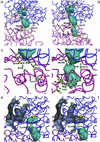Crystal structure of a bifunctional aldolase-dehydrogenase: sequestering a reactive and volatile intermediate
- PMID: 12764229
- PMCID: PMC165818
- DOI: 10.1073/pnas.1236794100
Crystal structure of a bifunctional aldolase-dehydrogenase: sequestering a reactive and volatile intermediate
Abstract
The crystal structure of the bifunctional enzyme 4-hydroxy-2-ketovalerate aldolase (DmpG)/acylating acetaldehyde dehydrogenase (DmpF), which is involved in the bacterial degradation of toxic aromatic compounds, has been determined by multiwavelength anomalous dispersion (MAD) techniques and refined to 1.7-A resolution. Structures of the two polypeptides represent a previously unrecognized subclass of metal-dependent aldolases, and of a CoA-dependent dehydrogenase. The structure reveals a mixed state of NAD+ binding to the DmpF protomer. Domain movements associated with cofactor binding in the DmpF protomer may be correlated with channeling and activity at the DmpG protomer. In the presence of NAD+ a 29-A-long sequestered tunnel links the two active sites. Two barriers are visible along the tunnel and suggest control points for the movement of the reactive and volatile acetaldehyde intermediate between the two active sites.
Figures





References
-
- Ovadi, J. (1991) J. Theor. Biol. 152, 1–22. - PubMed
-
- Srere, P. A. (1987) Annu. Rev. Biochem. 56, 89–124. - PubMed
-
- Chaudhuri, B. N., Lange, S. C., Myers, R. S., Chittur, S. V., Davisson, V. J. & Smith, J. L. (2001) Structure 9, 987–997. - PubMed
-
- Hyde, C. C., Ahmed, S. A., Padlan, E. A., Miles, E. W. & Davies, D. R. (1988) J. Biol. Chem. 263, 14925–14931. - PubMed
-
- Kim, J. H., Krahn, J. M., Tomchick, D. R., Smith, J. L. & Zalkin, H. (1996) J. Biol. Chem. 271, 15549–15557. - PubMed
Publication types
MeSH terms
Substances
Associated data
- Actions
LinkOut - more resources
Full Text Sources
Other Literature Sources
Molecular Biology Databases

